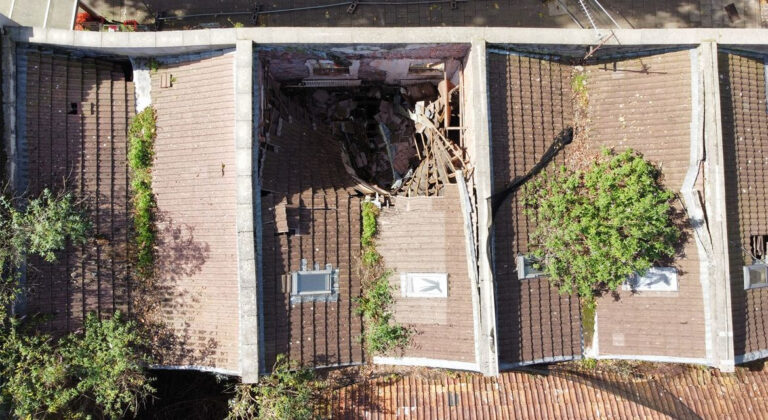Analysis: The national high-rise saga behind Barton House’s emergency evacuation

Photos: Alexander Turner
After World War II, there was a national drive to build a generation of urban social housing and ministers wanted councils to get as much housing as possible out of the land they had available.
As a result, they told them to build upwards. The grant subsidy system was engineered to actively encourage the construction of a new generation of high rise tower blocks.
The tower blocks which form the skyline of many of our cities rose from the ground in the three decades after World War II thanks to this drive. But many of these blocks were built on the cheap.
In particular, a new form of building became popular in the 1950s and 1960s – large panel systems (LPS) construction. This meant pre-forming slabs in a factory, driving them to a building site and bolting them together to form an enormous concrete tower.
Barton House in Bristol is one of the towers which emerged from this process. Completed in 1958, the 15-storey building was the tallest outside of London in the year of its completion.
But building so high and so fast came at a cost. In Canning Town, in east London, a similar LPS block called Ronan Point was completed in March 1968 and was blown apart by a gas explosion just two months later.
And now, 400 residents of Barton House were ordered to leave their homes because the council had discovered that the building risked collapsing in case of a fire or explosion. The Cable has been reporting on the impact on those who had to leave their homes, and previous warnings about structural issues at the block.

Back in 1968, eyewitnesses reported that a corner of Ronan Point collapsed like a ‘house of cards’. If the collapse hadn’t happened at 5.45am in a corner of the building used for kitchens when most residents were asleep in their beds, the death count would have been vast. As it was, five residents were killed and many more traumatised.
Investigations into the building work in the years that followed revealed that the joints between the concrete slabs were packed with tin cans, old cement bags, newspaper, and cigarette packets. The bolts holding the heavy concrete together were ill-fitting, bent and broken and had been sawn to fit in some cases.
But this triggered a national problem. There were at least 600 other LPS buildings around the country – including eight in Bristol.
Government policy in the 1970s said strengthening work should be carried out – but there was no oversight to ensure this was done.
And since the 1970s, these blocks have been largely forgotten. For many, they have not been well looked after. Water has leaked in between the concrete slabs, damp and mould has appeared and large cracks have started to appear in the structures.
Lack of structural surveys
Barton House is just the latest in a line of several ageing LPS buildings to be evacuated in recent years as these problems have emerged.
In a statement, mayor of Bristol Marvin Rees said structural surveys were undertaken at Barton House “to assess potential future options… given its age and method of construction”.
He said these surveys showed serious problems: an “apparent lack of structural ties between the floors and the load-bearing external walls” and “less concrete cover than set out in the original plans for the floors”.

We don’t yet know why Bristol was apparently entirely unaware of these risks until now, but it may well be that it had simply not done a detailed structural survey until this point.
While it has done work to the building in recent years, and carried out regular fire risk assessments in the wake of the Grenfell Tower Tragedy, which identified structural issues, this was not as comprehensive as the structural survey that sparked the evacuation.
In fact, there has been no legal requirement to carry out regular structural surveys of high rises until the Building Safety Act 2022 came into force last year.
As one safety manager at a social landlord, with a number of LPS buildings, told me in September: “Our LPS buildings are 60 years old, and they’ve never had any kind of structural scrutiny. They’ve had some historic strengthening work, but then no subsequent follow up… . I think it’s going to become the next crisis because it’s been ignored.”
This appears to be the position Bristol has found itself in. An FOI response unearthed today by the People’s Audit suggested Barton House has not had a structural survey since the post-Ronan Point strengthening in the 1970s.
We don’t yet know what will happen next to the building. Rees’ statement said the evacuation will allow further detailed surveys, which can help the council “understand when it would be safe for residents to move back in”.
It might be that it can be strengthened and made safe. This has been done before. Structural engineers can add carbon fibre or steel supports to the vertical ‘ties’ between the concrete slabs, bringing a building up to modern standards of structural stability.
But there have also been blocks which have deteriorated to such an extent – or were so badly built in the first place – that this is impossible.
And so the residents of the block now find themselves in the parlous position many other residents of LPS buildings have faced before when these issues have emerged.
If the council tells them the building is safe and they should move back in, can they be sure it is correct?
After the collapse at Ronan Point, strengthening and rebuilding work was carried out and residents were told to move back in or lose their tenancies.
It took a near 20-year campaign to have the building demolished and get them rehoused. When it was finally pulled down, it emerged that it had been in such a bad condition that high winds could have caused a collapse.
Barton House residents need reassurance
Collapse is no small risk. It is only a couple of years since 98 lives were suddenly lost in the Miami Surfside building collapse. A similar disaster in an LPS building cannot be ruled out. Will anyone who was just hustled out of Barton House late yesterday evening want to move back in with this in their minds?
But equally, if they are told the building cannot be saved and needs to be demolished, can they be confident they will get rehoused on the same rents in the same area?
And can they be confident that the site will remain council housing, instead of being gobbled up by a private developer?
There have been instances where social landlords have chosen demolition not because it is genuinely the only safe option for an LPS block, but because it is the cheaper one, or because it fits with an existing plan to ‘regenerate’ the estate through demolition.
Bristol City Council should agree to complete openness. This means being willing to share surveys and reports for public scrutiny as they are delivered. It also means giving residents a say if there is a choice over what happens, and respecting their wishes if they don’t want to move back in.
The council should also give on the record guarantees about rehousing, whatever the ultimate outcome for Barton House.

For now, residents need support. The stay in temporary accommodation is likely to be protracted and difficult. The experience of residents in east London who found themselves in a similar position in 2021 was miserable.
The reality is that we should never have reached this position with these buildings. We have known about the risks since 1968. The blocks should have been proactively monitored down the years, both by national government and the social landlords who own them.
That way, we could have ensured they were maintained properly and replaced with more modern social housing if that became necessary.
Failing to do this means we are reacting to a crisis – and one which might spread around the country. The consequence is the sort of last-minute, panicked and traumatic evacuation which Bristol witnessed on Tuesday night.
This is a story about failed housing policy, first straight after World War II and then in the decades since. Like so many other problems in housing, this crisis is made of neglect. And like so many other problems, it is the residents who suffer the cost.
Peter Apps is journalist for Inside Housing and author of Show Me The Bodies – How We Let Grenfell Happen, which won the Orwell Prize.
The Cable is currently raising money for the residents of Barton House. Find out more.

















Report a comment. Comments are moderated according to our Comment Policy.
I live in Gilton House and am in the middle of a battle to get compensation from BCC for the incompetent way in which refurbishment of the block is being done. The situation at Barton House is likely to lead to a much bigger housing crisis as BCC tower blocks are beginning to show their age and the corrupt way in which they were built. We need a city-wide and independent council tenants’ organisation both to defend our immediate interests and to promote good-quality and democratically controlled council housing as the obvious solution to the housing crisis. I have been trying to push this both at Council-organised “tenant participation” meetings and with Acorn but am getting nowhere. I don’t understand why.
Last I heard BCC are telling people to move back in on the advice of Ridge and Arup reports. Experts dispute the findings of these reports but have been shut down by BCC and their opinion undemind. This is scandalous. The blocks are unsound, the latest reports are unsound and the reasoning of BCC is unsound. Its a sham with residents’ lives on the line.